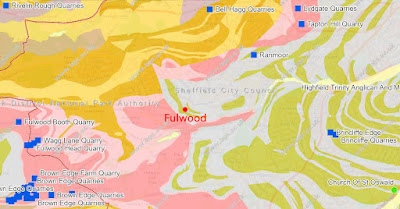 |
| Christ Church in Fulwood |
After having a look at the stonework at the former Ranmoor Council School and taking a few record photographs, I set off up Fulwood Road on my way to the former Fulwood Board School with a map and details of the listed buildings that I wanted to photograph for the British Listed Buildings website on this walk.
I had never explored the area around Fulwood before but, as always, I was very interested to see how the various building stones that I could see in the vernacular architecture related to the underlying geology – which comprises the sandstones of the Redmires Flags, the Rough Rock and the Crawshaw Sandstone and intervening mudstones and siltstones.
Looking at the 1855 Ordnance Survey map for the area, I can see the occasional small quarry but, as detailed on the Strategic Stone Study map – produced jointly by the British Geological Survey and Historic England – the main concentration of quarrying in this part of Sheffield was in the area around Brown Edge, which exploited the Rough Rock to the west of Ringinglow.
Although not listed, the Old Coffee House on the Old Fulwood Road is a good example of late Georgian vernacular architecture, with the walling containing a large proportion of rusty brown massive sandstone, coarse massive sandstone dressings with a roughly tooled finish and a roof made of sandstone tiles.
This walling stone reminds me of the sandstone that I had seen at the Tapton Hill Methodist Church in Crosspool, which is a short distance from the large old quarries that were exploiting the Rough Rock on Lydgate Lane for general building stone.
The nearby Guildhall, dated 1824, is also built in massive sandstone that contains blocks with the same rusty brown colour and has stone tile roofs that, as with those at the Old Coffee House will have been quarried from the Rough Rock. The Lydgate Lane quarries are less than 2.5 km away, as the crow flies, and had a much better network of connecting roads than the Brownlow Quarries at Ringinglow, which are twice as far away.
Continuing up Fulwood Road, I stopped very briefly to photograph the Fulwood war memorial, a simple Portland stone structure that is described by Historic England as having an octagonal shaft, with cross gables and topped by a Celtic cross.
I next encountered the Grade II Listed Christ Church, which was originally built 1837-1839 by Robert Potter but with major alterations to the south aisle and east end in 1953-56, the addition of the north aisle c1963 – all by the practice of the modernist church architect George Gaze Pace – with Ronald Sims, who took over the practice when Pace died in 1975, adding the west end stair turrets in 1981.
At the time of my visit, building work was being undertaken and in places I could only make observations of the stonework from a distance; however, different sandstones have been used for the various phases of building, with a yellowish iron stained Coal Measures sandstone used for the east end, with a contrasting greyish massive sandstone used for the walling of the aisles.
The British Research Establishment Report: The Building Sandstones of the British Isles states that medium/coarse grained Stoke Hall stone from the Kinderscout Grit in Grindleford, Derbyshire, has been used for the west turrets.
It is yellow in colour and finer grained in texture, compared to the greyish, medium/coarse sandstone used for the tower, which looks like it could be from the Chatsworth Grit in Sheffield, although I didn’t notice any obvious pebbles and I would need to undertake a much closer investigation of the masonry.











This is a really useful resource for better understanding the heritage and geological value of the area I grew up in. Thanks!
ReplyDelete